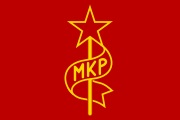Hungarian Communist Party
Party of Communists in Hungary (1918–1919; 1922–1943) Socialist Party of Hungary (1919) Party of Socialist Communist Workers in Hungary (1919) Peace Party (1943–1944) Hungarian Communist Party (1944–1948) | |
|---|---|
Comintern (1919–1943) | |
| Colors | Red |
| Party flag | |
 | |
The Hungarian Communist Party (Hungarian: Magyar Kommunista Párt, abbr. MKP), known earlier as the Party of Communists in Hungary (Hungarian: Kommunisták Magyarországi Pártja, abbr. KMP), was a communist party in Hungary that existed during the interwar period and briefly after World War II.
It was founded on November 24, 1918, as Party of Communists in Hungary, and was in power between March and August 1919 when
Foundation and early years

The Communist Party of Hungary (KMP) was first established as The Party of Communists in Hungary in late 1918 by
After the establishment of the
and forced the KMP to hand over power to the Social Democrats.Interwar period and exile
The fall of the Soviet Republic was followed by a year-long anticommunist purge, known as the White Terror, by the new nationalist government under István Bethlen in which anywhere from 1,000 to 5,000 people were killed, and thousands more were imprisoned and tortured. Much of the old KMP leadership was executed or exiled, primarily to Vienna. There, remnants of the KMP Central Committee, once again led by Kun, reformed into a Provisional Central Committee, which attempted to keep the party together despite its illegal status in Hungary.
Throughout the 1920s, many Hungarian Communists moved to Moscow, with Kun among them. Kun's actions in Russia, most notably the organization of a massacre of
The party also organised a legal cover party, the Socialist Workers Party of Hungary (MSzMP), to act as its representative in Hungary. However, the Hungarian government soon took steps to abolish the MSzMP, and by 1927, the party existed in name only.
For the remainder of the interwar period, the internal leadership of the KMP beyond Kun fluctuated tremendously, and membership was minuscule. After the deadly derailment of a passenger train at Biatorbágy by Szilveszter Matuska in 1931, the government declared martial law and used the opportunity to arrest suspected communists. Two of those arrested, and the leading party members Imré Sallai and Sándor Fürst, were executed the following year. The KMP was damaged to the point that the Comintern dissolved it in 1936.
Further throwing the communists into disarray were the inconsistent policies of the Comintern throughout the 1930s, which culminated in the 1939
World War II and Communist takeover
The KMP entered the 1940s a shell of what it once was. In late 1941, following Germany's invasion of the Soviet Union, the Central Committee advised Party members to work with non-Communist resistance groups in order to present a united anti-German front. This prompted the KMP to attempt to re-establish itself as a legal entity in Hungary, despite the Horthy government's alliance with Nazi Germany. This movement was quickly put to an end, however, as mass arrests in 1942 effectively destroyed the leadership of the KMP. This, coupled with the dissolution of Comintern in 1943, spelled the end of the KMP as a functioning party for the time being.
In an effort to continue their actions, Hungarian Communists under János Kádár founded a new party, dubbed the Peace Party, as a replacement for the KMP. This designation lasted until late 1944, at which point the Peace Party reverted to its designation as the Communist Party. By this point, Horthy was frantically trying to end Hungary's role in the war. Attempts to scale back the involvement on the German end failed, and so, with the Red Army approaching the country's borders, Horthy tried to declare Hungary a neutral state. The move backfired horrendously; the Arrow Cross Party forces seized the capital, took power, and set the stage for a four-month battle that claimed thousands of lives and left Budapest in ruins. The city was finally liberated in February 1945.
Despite rapid growth in membership immediately following the war, the party refounded under the name MKP received 17 percent in the elections, equal to the
Within two years, the MKP had broken the power base of the
Electoral history
Diet Elections
| Election date | Leader | Number of seats | Alliance | Rank |
|---|---|---|---|---|
| 1944 | Mátyás Rákosi | 166 / 498
|
1st | |
| 1945 | Mátyás Rákosi | 70 / 409
|
MSZDP–NPP
|
3rd |
| 1947 | Mátyás Rákosi | 100 / 411
|
MSZDP–NPP
|
1st |
Leaders
- Béla Kun (1918–1936)
- János Kádár (1943–1944)
- Mátyás Rákosi (1944–1948)
Prominent members
- Ernő Gerő
- Béla Kun
- Imre Nagy
- József Pogány
- László Rajk
- Mátyás Rákosi
- László Rudas
- Tibor Szamuely
- Ilona Duczynska
See also
- Hungarian Socialist Workers Party
- History of Hungary
- Hungarian People's Republic
Bibliography
- Crampton, R.J. Eastern Europe in the Twentieth Century - And After, 2nd Ed. Routledge Press, 1994.
- Kenez, Peter Hungary from the Nazis to the Soviets: The Establishment of the Communist Regime in Hungary, 1944-1948, Cambridge University Press, 2006
- Kovrig, Bennett. Communism in Hungary: From Kun to Kadar. Hoover Institution Press. Stanford, 1979
- Molnár, Miklós From Béla Kun to János Kádár: Seventy Years of Hungarian Communism, Berg Publishers, 1990
References
- ISBN 9632174771) - PAGE: 13
